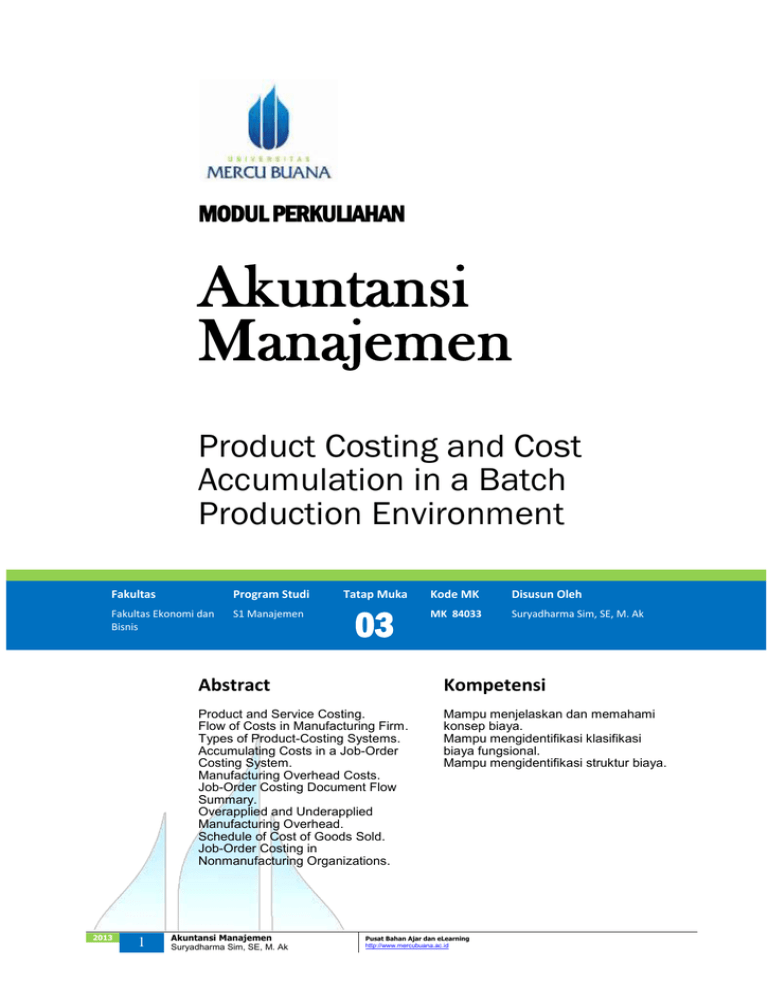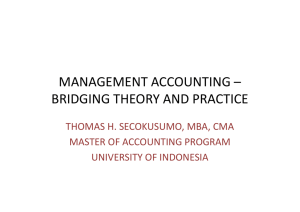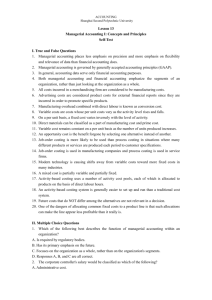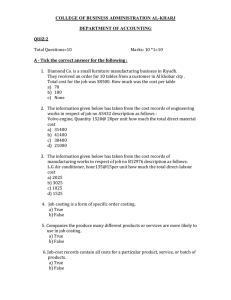Types of Product-Costing Systems
advertisement

MODUL PERKULIAHAN Akuntansi Manajemen Product Costing and Cost Accumulation in a Batch Production Environment Fakultas Program Studi Fakultas Ekonomi dan Bisnis S1 Manajemen 2013 1 Tatap Muka 03 Kode MK Disusun Oleh MK 84033 Suryadharma Sim, SE, M. Ak Abstract Kompetensi Product and Service Costing. Flow of Costs in Manufacturing Firm. Types of Product-Costing Systems. Accumulating Costs in a Job-Order Costing System. Manufacturing Overhead Costs. Job-Order Costing Document Flow Summary. Overapplied and Underapplied Manufacturing Overhead. Schedule of Cost of Goods Sold. Job-Order Costing in Nonmanufacturing Organizations. Mampu menjelaskan dan memahami konsep biaya. Mampu mengidentifikasi klasifikasi biaya fungsional. Mampu mengidentifikasi struktur biaya. Akuntansi Manajemen Suryadharma Sim, SE, M. Ak Pusat Bahan Ajar dan eLearning http://www.mercubuana.ac.id Types of Product-Costing Systems Job-order costing is used by companies with job-shop operations or batch-production operations. In a job-shop environment, products are manufactured in very low volumes or one at a time. In job-order costing, each distinct batch of production is called a job or job order. The cost-accounting procedures are designed to assign costs to each job. Then the costs assigned to each job are averaged over the units of production in the job to obtain an average cost per unit. In a batch-production environment, multiple products are produced in batches of relatively small quantity. Examples include furniture manufacture, printing, agricultural equipment, and pleasure boat production. Examples of a job-shop environment include feature film production, custom house building, ship building, aircraft manufacture, and custom machining operations. Job-order costing is also used in the service industry. Process costing is used by companies that produce large numbers of identical units. A process-costing system accumulates all the production costs for a large number of units of output, and then these costs are averaged over all of the units. Firms that produce chemicals, microchips, gasoline, beer, fertilizer, textiles, processed food, and electricity are among those using process costing. In these kinds of firms, there is no need to trace costs to specific batches of production, because the products in the different batches are identical. Job Order Costing Used for production of large, unique, high-cost items. Built to order rather than mass produced. Many costs can be directly traced to each job. TWO TYPES: o 2013 2 Job-shop operations Products manufactured in very low volumes or Batch-production operations Multiple products in batches of relatively small quantity. Akuntansi Manajemen Suryadharma Sim, SE, M. Ak Pusat Bahan Ajar dan eLearning http://www.mercubuana.ac.id one at a time. the warehouse supervisor. There it is used as the basis for transferring the cost of the requisitioned material from the Raw-Material Inventory account to the Work-in-Process Inventory account, and for entering the direct-material cost on the job-cost record for the production job in process. The assignment of direct-labor costs to jobs is based on time records filled out by employees. A time record is a form that records the amount of time an employee spends on each production job. The time record is the source document used in the cost-accounting department as the basis for adding direct-labor costs to Work-in-Process Inventory and to the job-cost records for the various jobs in process. Manufacturing overhead is a pool of indirect production costs, such as indirect material, indirect labor, utility costs, and depreciation. These costs often bear no obvious relationship to individual jobs or units of product, but they must be incurred for production to take place. Therefore, it is necessary to assign manufacturing-overhead costs to jobs in order to have a complete picture of product costs. This process of assigning manufacturing-overhead costs to production jobs is called overhead application. A predetermined overhead rate is used to apply overhead on the job-cost record. Once manufacturing overhead has been applied, the cost summary can be completed. Total direct material costs, total direct labor costs and total manufacturing overhead costs are added together to determine total costs. These costs are divided by the number of units completed to arrive at the unit cost. The shipping summary is completed when the completed units are shipped to the customer. This summary shows units shipped, units remaining and the cost of the units remaining in inventory. 2013 3 Akuntansi Manajemen Suryadharma Sim, SE, M. Ak Pusat Bahan Ajar dan eLearning http://www.mercubuana.ac.id



